Abstract
Since the mid-1990s, Singapore’s Chinese religious landscape has seen the rapid development and popularisation of Netherworld spirit medium (tang-ki) cults based around the channelling and worship of two Underworld deities, Tua Ya Pek and Di Ya Pek. Emphasizing Earthly morality and post-mortal punishments in the Underworld, the tradition has developed a distinctive ritual and material culture. The Temple of Mysterious Virtue illustrates this culture, is broadly representative of successful tang-ki temples where both Underworld and Heaven deities are channelled in a multi-ethnic environment, and where orthodox Taoist priests and tang-ki mutually reinforce each other’s legitimacy through ritual cooperation.
The Temple of Mysterious Virtue is broadly representative of successful Chinese spirit medium (tang-ki) temples in Singapore that have outgrown the confines of HDB apartments and relocated to larger premises in cheaper industrial areas. Reflecting a trend instigated by Singapore’s Housing Development Board of relocating citizens “in public housing neighbourhoods with representations of Malay, Chinese and Indian residents that were reflective of the ethnic mix at the national level […] 77 per cent Chinese residents, 15 per cent Malays, 7 per cent Indian” (Teo et al. 2004: 99), this temple caters to a multi-ethnic and multi-religious community. Located high above the sprawling metropolis in west Singapore, Chinese, Malay and Hindu deities are worshipped and Chinese and Hindu deities are consulted by their devotees through their spirit mediums. The temple was originally founded by a child medium in his parent’s HDB apartment in 1986, and this photo-essay details some aspects of last year’s annual anniversary celebrations (Figure 1).

Inviting the Generals of the Five Directions and feeding their stallions.
The first morning was devoted to inviting the Generals of the Five Directions to watch over and guard all ritual proceedings, a ritual invitation which included feeding their horses and which was performed daily. Reflecting the pragmatic nature of Chinese vernacular religion, the generals serve the temple they are housed in, and obey the temple’s tang-ki whose authority is legitimated by the Jade Emperor in a ritual performed at one of two Jade Emperor temples in the country. In Singapore, a tang-ki may only practice after receiving permission from the Jade Emperor, acquiescence ascertained by the casting of divination blocks (bue). Bue are two crescent shaped convex wooden blocks which may land either flat or convex sides facing up. When one convex side faces up and the other down, it signifies a ‘yes’ answer, the probability of receiving a positive answer being 50 %. However, this tradition of petitioning the Jade Emperor is absent in Taiwan, but has become increasingly important in Singapore with the increasing popularity of the Underworld deities Tua Ya Pek and Di Ya Pek who are often described by tang-ki as half deity – half ghost, and whose rank as Underworld enforcers would otherwise be insufficient to master heavenly generals. The Five Generals are the Jade Emperor’s nephew Er Lang Shen representing west; Lei Gong the God of Thunder representing east; Marshal Kang representing south; Zhao Gong Ming the Military God of Wealth representing north; and as overall commander, Prince Na Zha who holds the title of Marshal of the Central Altar – Zhong Tan Yuan Shuai representing the central camp. These are the principal commanders of the Heavenly armies, and individually, each holds a high rank in the Taoist pantheon. Therefore, even though as a group they are subordinate to the residing tang-ki, each general was invited individually with the respect commanded by their rank. Bue were then thrown to make sure that each had arrived, and then again to make sure that they were satisfied with the food and drink offered to them. Joss money was also burned for them to distribute to their spirit armies.
However, the main ritual activity on the first day was to invite the Jade Emperor to the celebrations, and to achieve this successfully, the tang-ki and a Taoist priest worked together, each undertaking different ritual functions. This cooperation between the folk and orthodox traditions is indicative of Singapore’s contemporary religious landscape. In Taiwan for example, while orthodox priests perform rituals in folk Taoist temples, they do not, as a rule, perform a ritual together with a spirit medium in a trance state channelling (trancing)[1] a deity.
There were some preliminary ritual entertainments for devotees and temple members to watch including lion dances and a dragon dance while more serious though less spectacular rituals were being performed elsewhere. Inside the temple, four tang-ki went into trance, two visiting tang-ki and the two temple owners. The male tang-ki tranced Jigong, Lotus Flower San Tai Zi, the Iron Axe Marshal Tiefu Yuanshuai and Lin Fu Wang Ye, and the female tang-ki, Guan Yin (Figure 2).
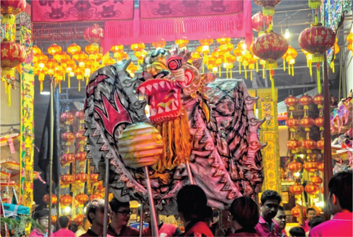
Representing auspiciousness, the dragon pays respects to the temple’s deities.
Once in trance, what resembled a theatre of pain was constructed running from the consultation table at the temple’s centre to the external altar to the Jade Emperor. A selection of ritual weapons were laid on the floor on joss money, and in turn, each of the male tang-ki self-flagellated with the them, their intent being to draw blood with which to daub ritual objects. The weapons used included two axes, two Dragon Tiger Swords, two machete with a serrated edge and a cudgel with 108 protruding spikes both referred to as a ‘shark’, and a nail ball consisting of 108 nails protruding from a wooden sphere. It is generally believed that the blood of a possessed tang-ki carries the blessings of the deity channelled, blessings which are transferred into the material objects. It is not uncommon for temple members to carry a sash which, when blood is let, is eagerly presented to the tang-ki to have its power fortified. I asked the tang-ki why such spectacle was required for the relatively small amount of blood required for the event, and he replied that it is natural to “display what one cherishes” and that the gift of blood was to “present a treasure” to the deity’s devotees. Some objects would be given to devotees, others had been paid for in advance, and some would be sold in the action that follows such festivals in Singapore to raise money for the temple. The most numerous objects were banners and lanterns with the temple’s name which devotees would hang over their front doors for a year to bring the blessings of the temple’s deities in to their homes (Figures 3 and 4).

Weapons used for ritual self-mortification.
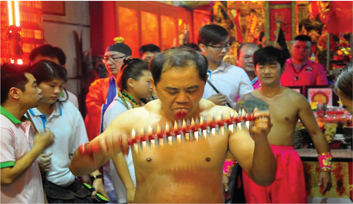
Drawing blood to add efficacy thus rendering material objects sacred.
Figure 2 illustrates the familiarity between the orthodox priest and the tang-ki who was trancing Jigong. The photo was taken earlier in the day and they were in fact discussing the order of the day’s rituals. As an employee, the priest deferred to the tang-ki’s decisions, and in return, the tang-ki made clear to devotees that the priest was essential and important in the ritual arena. In the rare instances where the priest felt he could not participate as required in a ritual that had been invented by the temple and conflicted with orthodox practice, he would instead chant a scripture of blessings for the benefit of devotees. Therefore, unknown to participants, on these occasions, two unconnected rituals were being performed simultaneously – the intended ritual by the tang-ki accompanied by orthodox liturgical chants (Figure 5).
[Correction added after online publication 8 September 2016: “The photo to the right illustrates”… was be replaced by “Figure 2 illustrates…”]

Cooperation between religious specialists from the folk and orthodox traditions.
While the tang-ki were letting blood, outside at a separate altar, the priest had been chanting a scripture of inviting for the Jade Emperor, the Wu Dan Zhou from the Zhengyi Taoist sect. The words of the scripture would mingle with the abundant incense smoke and be carried upwards towards Heaven, and the red candles on the altar would light the deity’s way to the altar. After each tank-ki had finished marking sacred objects, they moved outside to observe the priest’s rituals. This gave me the chance to talk with them and establish their relationship with the temple. As it turned out, each tang-ki had their own temple, the ritual connection between them being an extension of membership of the same triad brotherhood, the Bamboo United Society. Since the breakdown of pre-urbanization ritual networks based on village (kampong) or clan name associations, friendships forged during national service, in secret societies or at temple banquets have all functioned as new forms of temple networking in Singapore. This has created an environment whereby mutual participation by tang-ki in each other’s rituals has become the norm (Figure 6).

Taoist priest inviting the Jade Emperor at an external altar.
As the evening wore on, more rituals were performed by the priest including ‘opening the eyes’ of new statues bought by devotees. This is usually done by the tang-ki in trance at the Temple of Mysterious Virtue, but they relinquished the duty on this occasion. While the end result is that the statues become spiritually efficacious sacred objects, there are significant differences between the folk and orthodox belief systems and rituals. While the orthodox system considers statues as aids for contemplation, a means to pay respects to the deity and as a way of communicating with them, the emic belief of practitioners is that a deity statue with its ‘eyes opened’ becomes a receptacle for the deity whereby the deity can be brought directly into one’s home or temple. Whilst a tang-ki has the authority of the possessing deity to ‘open a statue’s eyes’, the priest, through liturgical invocations, attains the assistance of Heaven deities that he calls upon. In both cases, dissolved cinnabar is used with a small brush, and dots are placed on the top of the statues head, its eyes, ears, neck, shoulders, heart, hands, legs, knees and feet, as well as on any weapon or other articles the deity is holding. In the orthodox tradition, the vital organs are also ‘dotted’, and the priest uses a mirror to reflect light onto the deity statue to make its efficacy stronger. During the process, the Chinese character ling meaning ‘spirit’ is drawn on the mirror along with a secret talisman which the priest informed me was “to bring wealth, and to destroy malicious spirits with the mirror’s light” (Figure 7).
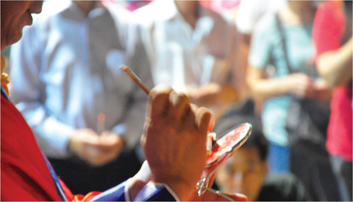
Using the power of a talisman and reflected light to ‘open the eyes’ of a deity statue.
Returning to the ritual invitation to the Jade Emperor, after much incense had been lit, joss paper burned, scriptures recited and offerings made, once again using bue, the Jade Emperor was asked whether he had accepted the invitation. When throwing bue, statistically the probability of receiving a ‘yes’ answer increases with each attempt from 50 % to 75 % with two casts, 87.5 % in three and 93.75 % in four. After four consecutive ‘no’ answers, Jigong stood up and encouraged everyone to pay respects to the Jade Emperor guaranteeing that if they prayed hard enough, he would agree to come. He jokingly picked up a baby and put its hands together and held it up and good humouredly cajoled the crowd into joining in. The bue were thrown again, and sure enough, the Jade Emperor acquiesced. However, he wasn’t to stay long. I was informed by the priest that traditionally people invited the Jade Emperor at 11am, and sent him off the same afternoon after reporting their activities to him, but that local customs have changed and nowadays he is invited at night and sent off the next afternoon. I suggested that this may be because in the religious calendar the day begins at 11PM or due to the fact that most devotees are busy in the daytime, but was then informed by the temple’s tang-ki that it was their intention to pray to him at first light, “at 5:45 in the morning we need to pray to him so that what we say to him he can hear. He is there to witness the first day of the event and then other deities can act as witness” (Figure 8).

Casting bue to confirm the Jade Emperor has accepted the offerings and invitation.
The primary ritual on the second day was therefore sending off the Jade Emperor, though individual consultations, healing, purification, and luck changing rituals were performed by the tang-ki throughout the day. I queried why the lesser ranked Generals of the Five Directions were invited every day and the Jade Emperor only for a single day, and it was explained that the Jade Emperor had far too many responsibilities to be present for the whole five days, the important thing being that all planned activities had been reported to him and acknowledged in advance.
The sending off ritual was spectacular and involved several priests and tang-ki, and numerous food offerings. These included five fruits representing the five elements and five directions, and a pig’s head and tail – the latter necessary to signify that it was in fact a whole pig, the remainder of the animal being offered to the Generals of the Five Directions and then eaten by devotees to bring them blessings. Following the same procedure as the night before, once it was ascertained that the Jade Emperor was satisfied with the proceedings, his altar which had been set up outside the temple was dismantled, then transported to public incineration bins along the main road to be ‘sent off’ in flames back to the heavenly realms. Of key interest is that the altar included a palace constructed of cardboard which was richly decorated with figures of deities and shrouded with sugar cane. Previously such palaces would have been absent, but with increasing wealth, festivals in Singapore have become increasingly elaborate, and to ‘gain face’ i. e., ‘to keep up with the neighbours’, palaces and other combustible paraphernalia have become progressively larger. The priest expressed this succinctly, “this is not related to Taoism; this is about abundance”. Only one item was spared the flames, an image of a god of wealth Qilin Caishen placed on a stack of joss money which, from the tang-ki’s perspective, meant that wealth would continue to flow in to the temple with the Jade Emperor’s blessing in the coming year. The inclusion of sugar cane is a Hokkien tradition based on numerous versions of a story in which imperial Chinese or Japanese soldiers came to massacre villages in Hokkien speaking areas, and villagers escaped by hiding in sugar cane fields. A more recent example from Singapore is that of Hokkien speaking civilians escaping death in the first few weeks of the Japanese occupation of Singapore in February 1942 by hiding in sugar cane fields that they had planted. An alternate explanation is based on homonyms whereby the Hokkien word for sugar cane is ‘gam jia’ (甘蔗) which sounds similar to gratitude, ‘gam xia’ (感谢). Other examples of homonyms being the basis for the creation of symbolic objects include altar offerings such as apples ‘ping guo’ (苹果) as in Mandarin the first syllable sounds the same as ‘pingan’ (平安) meaning ‘peace’; bananas, as both banana (香蕉) and ‘gold beckon’ (金招) in Hokkien are pronounced ‘gim jio’; pineapple (凤梨) as the Hokkien is pronounced the same as ‘prosperity come’ ‘ong lai’ (汪来), and oranges as in Hokkien the first syllable ‘gel’ (桔) from ‘gela’ (桔子) sounds the same as the first syllable from the Hokkien word for ‘auspicious’ ‘dai gel’ (大吉) (Figures 9 and 10).
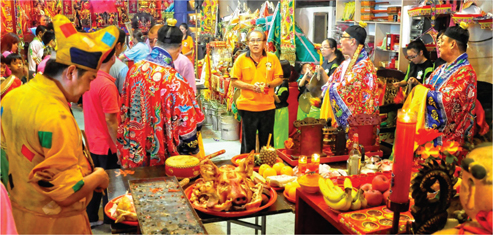
Showing gratitude and respect at the Jade Emperor’s altar.
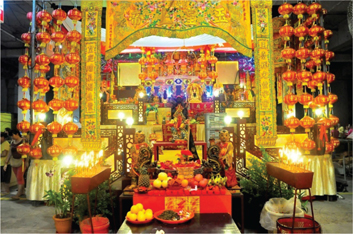
A temporary palace for the Jade Emperor’s use behind his altar.
The highlight of day three was the ceremonial crossing of a pingan bridge, a bridge crossing that removes negative energies from one’s mind, body and soul, changes one’s luck for the better, and brings blessings from deities. Lacking ritual space inside the temple, the Temple of Mysterious Virtue set up its pingan bridge in the parking lot immediately outside the temple under the auspices of a black flag referred to in Hokkien as the ‘orh leng’ representing the Lord of the Dark heavens Xiantian Shang Di, and the flags for the external camps of the Generals of the Five Directions (Figures 11 and 12).

Removed from the Jade Emperor’s palace, Qilin Caishen will draw wealth into the temple over the coming year.

Summoning deities to guard the pingan bridge and surrounding ritual space.
Candles and incense were lit at eight points marking each of the primary compass points and thus corresponding to the eight sides of the bagua, each set of incense and candles invoking the protection of a deity: Heaven, Earth, the Lord of the Southern Dipper, the Lord of the Northern Dipper, North, South, East and West as well as the Eight Taoist Immortals. Alongside each set were offerings of tea as a sign of respect to the deity, oranges representing auspiciousness and joss money to pay for the deity’s services as their work is contractual and they do not work for free. Beneath the bridge was a bowl of scented water symbolising a river and an oil lamp was placed inside, not representing fire, but instead symbolic of the moon reflecting light onto the river. The five coloured cloth on the bridge represents the Generals of the Five Directions, and also the five elements that are believed to constitute the Taoist universe, air, earth, fire, wood and metal. The pingan rituals were shared, the priest performing the opening and closing rituals, and two tang-ki bestowing blessings while guarding the bridge entrance and exit. Temple members prepared the ritual space, and the temple’s primary tang-ki who was trancing Jigong coordinated the ritual activity (Figures 13 and 14).

The candle in water representing the light of the moon on a stream.

Jigong leads temple members over the bridge.
The first deities to be invited by the priest were three boundary guards charged with securing the area, followed by the Generals of the Five Directions to prevent malevolent spirits from approaching the bridge. The Bridge General Qiao Qian Jiangjun was then invited to an altar set up facing the bridge’s exit, and finally the tutelary deity Tudi Gong was invited. As each deity was summoned, he held a corresponding flag in his left hand to write a ‘qi’ talisman in the air, while with his right he wielded a snake headed whip which was cracked five times for each deity. Each time the knotted cord broke the sound barrier, it produced a sound reminiscent of a thunder clap, a sound associated with the deity Lei Gong who in popular mythology produced thunder with a drum and mallet to kill demons and those who misused Taoist magic. It is this sound and not the whip itself that wards off malevolent spirits and black magic. Finally, the red buns on the bridge, each representing obstacles that individual’s face in life were removed with the tip of the priest’s sword, thus symbolically removing these obstacles from the lives of devotees who would later follow him over the bridge.
There was a buzz of excitement as devotees gathered themselves into groups based on their Chinese zodiac birth year, each of which would cross in turn, but first, led by Jigong, temple members crossed the bridge. The entrance to the bridge is called the Dragon Gate where negative energies are removed and the exit the Tiger Gate where negative energies are prevented from following, and crossing, perhaps due to expectation, produces a feeling of elation. At the enterance stood the tang-ki trancing Lotus Flower San Tai Zi, his job being to prevent any spirit entities from following the last person to cross in each group. At the exit stood Zhong Tan Yuan Shuai who, in his role as the military commander of the Armies of the Five Directions held spiritual dominium over the bridge. As each participant passed, he touched them lightly on the head with his flag before exiting the Tiger Gate. In Taoism, deity power ‘ling’ is transmitted through flags, and as the blessing was bestowed, it felt as if an electrically charged cool breeze (qi) was passing through one’s body starting at one’s head and exiting into the floor through one’s feet. After crossing, each participant paid respects at the altar of the Bridge General who, in the folk tradition, is believed to help clear obstacles from devotee’s paths (Figure 15).

Zhong Tan Yuan Shuai bestowing blessings through his flag.
Non-members were each given three incense sticks, joss money, and either a male or female effigy called a tishen to carry across the bridge. Tishen are perceived as a substitute body that will both absorb bad fortune and trick malevolent spirits into thinking that the effigy is the individual, so that if a spirit had been following a person for reasons of their own, they would be incinerated along with the effigy and joss paper at the end of the ritual. Prior to opening the bridge to the public, the priest carried thirteen tishen across the bridge. He explained that “men have less misfortune than women as women have the additional hazard of childbirth. As we were changing luck for twelve months, I carried six males and seven females, one for each month, plus one for the danger associated with giving birth” (Figure 16).

Tishen providing participants a proxy self in the spirit world.
After all twelve animal signs had crossed, led by the Taoist priest and temple members, everyone crossed for a second time carrying eleven incense sticks which were then taken into the temple to pay respects at the eleven censers dedicated to different temple deities. In order these include Xuantian Shangdi represented by the orh leng; the Jade Emperor; Shancai Tongzi and other Heavenly deities (the main censer); the One Thousand Armed Guan Yin; the Generals of the Five Directions; the year god Tai Sui; the Underworld pantheon, most prominent of which are the City God Cheng Huang, Tua Ya Pek and Di Ya Pek; the Hindu deity Ganesh; the Malay Datuk Gong; the Tiger God representing wealth, and lastly two dogs guarding the Heavenly and Underworld altars (Figure 17).

Qi or aura cleansing to conclude the pingan bridge rituals.
After offering incense, each devotee was given a cleansing ‘rub’ with their joss money by Jigong. The variety of money used was referred to as changing luck money gai yun qian, and the rub was intended to cleanse each individual’s aura. This concluded the pingan bridge ritual.
Meanwhile, outside, the Taoist priest dismantled the pingan bridge with a sword whose blade was inlaid with stones representing the stars of the Big Dipper. After the ritual items had been removed and the deities informed to return to the temple, the bridge was lifted a foot in the air and dropped, the sudden crash breaking the link between the human and spirit worlds (Figure 18).

Desacralising the pingan bridge.
The remainder of the evening was dominated by two events. First, temple members began to prepare for the penultimate day’s chao du rituals for their ancestors, and inside the temple, consultations with Guan Yin as tranced through her medium began. As she gave out words of wisdom and advice, most devotees became very moved, some even to tears (Figure 19).

Guan Yin as tranced through her tang-ki offers sagely advice.
For most participants, the chao du ceremony for ancestors was the most important element of the five-day event. For those with recently deceased relatives, it represented a way of making sure that they made a speedy passage through the Underworld to their next incarnation, and for others, a way of showing respect to their ancestors and of gaining extra blessings from them in return for offerings. While initial preparations were being made for the chao du on the fifth day, rituals were held on day four for the younger generations to help them focus on their school work and to pass their exams.
Both the Taoist priest and Jigong participated in this ritual, the active agency though being the god of exams, Kui Xing. Each family had a tray of ritual objects including black paper graduation hats, red paper hats called guan mao which would have been worn by high ranking officials in ancient China, paper robes, joss money, a gold casket in the shape of ancient Chinese money representing the Money Gods of the Five Directions Wu Lu Cai Shen, and some imitation graduation scrolls. All the objects were ‘dotted’ by Jigong thus ‘opening their eyes’ so that deities could work through them, and three coins with square holes also referred to as wu lu cai shen were added by Jigong. Each object was then picked up by the priest and circulated three times over incense smoke while reciting a scripture. The students (or their parents in their absence) knelt before Jigong and had the hat placed on their heads symbolizing successful graduation, and the children were given encouragement to work hard. As dictated by the contractual nature of the belief system, all of the items bar the casket were then burned as offerings to Kui Xing (Figure 20).

Placing a dot of cinnabar solution on ritual items to add efficacy.
Overseen by the Underworld deity Di Ya Pek as tranced through his medium, ritual activity continued throughout the day. Di Ya Pek’s mood is usually sombre, but on this occasion he was as convivial and celebratory as I have ever seen him. In Figure 21 he can be seen blessing large sacks of rice which would be divided along with other essentials to be distributed to the elderly from the poorest families in west Singapore (Figure 21).
[Correction added after online publication 8 September 2016: “the photo to the right” was replaced by “Figure 21”.]

Di Ya Pek with his ghost catching chain blessing sacks of rice.
There had been a Chinese opera and puppet performances playing for the first three days, and his next task was to ritually dismantle their stage, removing the talisman placed there to protect the performers who it is believed may become possessed by the deities or historic characters that they or their puppets portray. In common with dismantling the pingan bridge, the talisman attached to it were burned, the deities they represented sent back to the temple, and then the stage was lifted and allowed to crash on the floor (Figure 22).

Martel Cordon Bleu: Underworld deity’s drink of choice.
Di Ya Pek then dedicated the remainder of the day to drinking with temple members, happily pouring Martel Cordon Bleu down their throats. Outside the temple, the preparations for the chao du continued, houses for both ancestors and wandering spirits were set up outside the temple entrance for the spirits to stay in overnight while awaiting the chao du offerings. The buildings were segregated with males and females each being allotted one floor, and at the end of the houses there were washrooms for all the spirits to use. As with food offerings, incantations to multiply their size in the spirit world were employed meaning that there was no correlation between the size of the actual paper building and the accommodation allotted for the use of ancestors and wandering spirits (Figure 23).

Accommodation for ancestral spirits.
The fifth morning was spent filling the tables with offerings to ancestors while at a separate altar, three priests chanted scriptures allowing for the post-mortem forgiveness of sins. The tables for offerings were set up immediately in front of a tent dedicated to Underworld deities, logic dictating that Underworld deities were best positioned to speed up processes happening in the Underworld. Their tent, as is usual in Singapore, was lit by black lights as Underworld deities are not accustomed to sunlight, and it contained statues of the primary Underworld deities as well as amusements for them including mah-jong, cards, alcohol and gambling chips. On the main altar were placed Bao Gong who is associated with judgement, Cheng Huang the City God, and from the Buddhist pantheon the bodhisattva Dizangwang Pusa who renounced enlightenment until the Underworld has been emptied of souls. Placed along the two remaining closed sides of the tent were the twenty-four helpers of Cheng Huang whose job is to record the deeds of every individual so that correct punishments can be inflicted in the afterlife (Figure 24).

Twelve of the City God’s scribes were placed on each side of the Underworld tent.
Meanwhile, inside the temple there was an unusual ritual taking place. In front of the altar table there was a trough of dried mixed beans similar to those used to feed the horses belonging to the Generals of the Five Directions. These particular beans though had been blessed by ‘The Boss’ (the highest ranked deity tranced by the spirit medium) Xuantian Shangdi, by the Taoist priests and finally by Di Ya Pek. They were clearly highly prized as they represented wealth in all its manifestations: mental, spiritual and material. Di Ya Pek sat in his throne, and the longest serving members of the temple approached him holding in their hands a small pouch of pink paper which Di Ya Pek filled from the store in the trough. The pouches were then carefully wrapped in plastic bags to stop any ‘wealth’ being lost. Di Ya pek then called me to the front and announced that I would be his representative, and leaned back in his throne and watched while each temple member approached me, bowed, and held out their pouches which, much to their delight, I generously filled. Once this ritual was over, Di Ya Pek returned to the Underworld to be replaced by Sai Ya Pek, an Underworld deity associated with filial piety who would oversee the chao du ritual (Figures 25 and 26).

Money and food for the ancestral spirits.

Liturgical chant to bring blessings to devotee’s ancestors.
Attention then moved outside and to the job of filling the tables of offerings. Each ancestor was offered food and money, and so that they could find their individual offerings, their names were added on yellow talisman held in place between layers of joss money. Incense was then lit in each object to attract the attention of the ancestors so that they could receive their offerings. While this provided the primary visual focus, the important rituals were those performed by the Taoist priests petitioning the Jade Emperor to bestow forgiveness and blessings upon the ancestors. As orthodox Taoism does not call upon the Underworld deities in rituals nor represent them in anthropomorphic form in temples, I inquired how they felt about performing the chao du ritual in front of the Underworld tent. They replied that it went unnoticed as their full attention “heart and soul” were focussed on acquiring merits to assist the ancestors in discarnate realms. For the wandering spirits, that is, ghosts who do not have descendants to make them offerings, scriptures of salvation and repentance were left open on the table for them to read. Once again the ritual was ended when bue confirmed that both the ancestors and Jade Emperor were satisfied with the proceedings, and that the offerings had been accepted.
The paper buildings which had housed the spirits overnight were then loaded onto trucks along with several tonnes of joss money, and much to my surprise, several tables of actual food and drinks. These were all then transported to the main road by truck and placed in incinerators for a grand ‘sending off’. According to the tang-ki, the ancestral spirits remain in the houses and return to other realms when the burning takes place, the earlier rituals preparing them to leave the mortal realm. In Singapore, fires are only permitted in government sanctioned locations, in this instance, large cages placed along the road next to the building where the temple is housed. Overseen by both the Taoist priest and Sai Ya Pek, bue were thrown again and after a ‘yes’ ascertained, the contents of the incinerators lit with incense and joss money. As the fire took hold, the priest rang a bell and uttered words of blessing while onlookers prayed for the benefit of their ancestors. Within a minute, the house used by the ancestors caught alight, and I stayed by the fire for perhaps twenty minutes watching the flames as they engulfed the food offerings (Figures 27–30).

The food will be transformed through immolation, thus releasing its spiritual essence.

Praying to ancestors as their souls are ‘sent off’ to the spirit world.

As the house burned, the souls within departed.
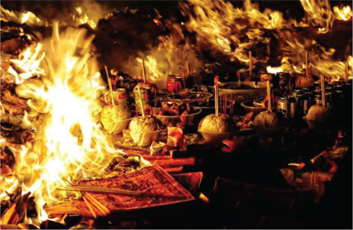
Money and food for use in the afterlife.
About 1:30 am on January 1st the flames died down and everyone returned to the temple.
The final day of celebrations was focussed on the annual banquet which functions both to raise money for the coming year through auctioning sacred objects, and as a means of networking as many of the banquet tables had been booked by other spirit medium temples. The banquet was held in a car park in front of the building where the temple is housed, and about one thousand people attended. Looking back to the first photo in this ethnography, that of the Generals of the Five Directions, for the auction, the clothes being worn by the deity statues were removed and each placed on a large pile of joss money, and along with the corresponding small hand painted talisman, sold individually for in excess of one thousand Singapore dollars each (Figure 31).

The winning bidder carrying off the ‘Urn of Prosperity’.
The most important ritual object sold at each banquet is the Urn of Prosperity. As a material object, it is an ordinary temple censor, but as a ritual object, it takes on a powerful significance. First, it is a miniature replica of the main censor in the temple; second, the urn has been ritually sanctified by the temple’s deity, and third, it has been used to pray to the temple’s deities by devotees, so it is considered in every way a replica of the main urn in the original temple. For the winning bidder, it represents that they are inviting this particular temple’s deities to their house as a guest for one year, and are therefore praying directly to them in their home or business. It also represents prosperity, as when you invite ta deity home, the deity will bring you good luck financially, and prosperity in all its other guises. The winning bidder for the Urn of Prosperity only gets to keep it until the following auction, and therefore it has to be returned to the temple after one year for re-auction. It can only be kept permanently by a family or business if they win the auction three years consecutively. Therefore, if a bidder has won the auction for this prestigious object for two consecutive years, they will bid exorbitant amounts to win for the third time so that the Urn of Prosperity becomes their own property. Both temple auctions and Urns of Prosperity which provide the major income for the majority of Singapore’s smaller temples are absent from Taiwan’s and Malaysia’s folk Taoist landscapes. The urn sold at this banquet for 10,888 Singapore dollars, 888 being an auspicious number, which is roughly 7,200 Euros.
Following the banquet, temple members returned upstairs to the temple to dismantle any remaining decoration, to replace previously hidden ritual objects in new secret places, and to put the deity statues back on the main altar. Once completed, the final ritual act of the anniversary celebration was the ‘sending off’ of payment to the Generals of the Five Directions and their steeds. For all the ‘sending off’s’, yellow talisman drawn by Xuantian Shangdi were attached to the incinerators to authorise the burning. As such, from the emic perspective, deities themselves provide the legitimization for ritual activities through their tang-ki, simultaneously legitimizing the power of the tang-ki to their followers (Figures 32–34).
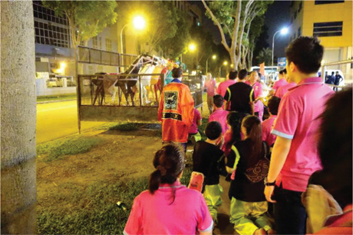
Preparing to ‘send off’ the stallions belonging to the Generals of the Five Directions.

Burning money as wages for the General’s troops.
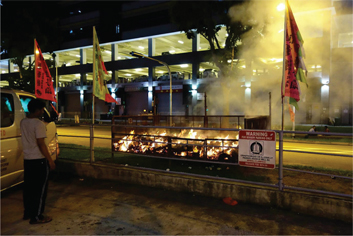
A migrant worker watching the flames die down.
And thus it was, in a spectacular blaze of fire, that the week’s ritual celebrations came to a successful end.
References
Teo, P., S. A. Yeoh, G. L. Ooi, and P. Y. Lai. 2004. Changing Landscapes of Singapore. Singapore: McGraw Hill.Search in Google Scholar
在突破政府组屋的局限,迁往相对便宜的工业区而得以成功地扩大经营的一批新加坡宫庙中,玉封南府玄善庙的华人灵媒(Tang-ki,童乩/乩童)活动是极具代表性的案例。受到新加坡建屋发展局搬迁计划的推动,“公共住宅区里有马来人、华人和印度人等居民,反映了本国多民族混合的状态[…]。其中,有 77% 的华人,15% 的马来人以及7%的印度人” (Teo et al 2004: 99),玄善庙正是顺应这种民族混合的趋势所建立起来的一个多元民族、多元宗教的社区庙宇,它位于新加坡这座不断扩张的大都市的西部,庙里同时供奉着华人、马来人和印度人的神祇,这些神灵会通过各自的灵媒,接受着不同民族的信徒的求助和膜拜。玉封南府玄善庙是 1986 年由一位乩童建立的,本文将详细描述该庙在 2014 年众神千秋寿诞大典上的一些重要的仪轨。
第一天上午举行的是安坛(即安五营)仪式。专门邀五营将军来守护整个仪式过程,这是一个需要每天操演的邀请仪式,包括每天给他们的战马喂食。 五营将军们为他们所在的宫观服务,并听令于该观的乩童,正是反映了中国通俗宗教(vernacular religion)的务实性。这位乩童是在新加坡两所玉帝庙之一,由玉皇大帝赋权任命的。在新加坡,乩童必须玉帝允准之后才能做法,而允准与否是通过投掷筊杯(Bue)来决定。圣杯(SengBue)是由两块新月形的木块组成,一面平滑,一面凸起,投掷落地的时候,会有平面着地和凸面着地两种情况。如果投掷后,一个凸面朝上,一个凸面朝下,就意味着 “是”,而得到肯定答案的几率是 百分之五十。随着冥界神灵大爷伯(TuaYaPek,即白无常)和二爷伯(Di YaPek,即黑无常)越来越受欢迎,这种向玉帝获准的仪式在新加坡也变得日益重要,而台湾并没有这种向玉帝请愿的传统。大二伯爷经常被乩童描述成半神半鬼,其排位是冥界的执法者,无权操控天庭兵将。 五营将军分别是代表西方的刘元帅,代表东方的张元帅,代表南方的康元帅,代表北方的连元帅,以及代表中央的众将统领、拥有中坛元帅之名的哪吒三太子李元帅。他们是天将的主要将领,并且分别在道教神仙里具有较高的地位。故此,即使他们作为一个整体,会听从于所在道观的乩童,每位大将也会分别受到与其尊位相当的恭请仪式,通过投掷杯筊依次确定每位大将是否已经到达,是否对供奉的茶点满意,并且给他们焚烧冥币,以分发给他们的灵兵神卒(见图一)。

邀请五营将军并喂饱他们的战马.
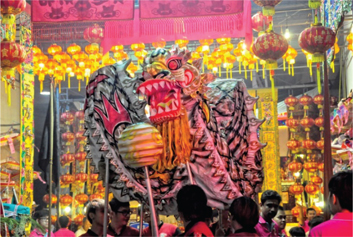
代表吉祥的舞龙来敬奉庙宇的神.
第一天的主要仪式活动是恭请玉帝,为了成功达成该目的,乩童和道士需要一起合作,分别承担不同的仪式功能。这项介于民俗传统与正统传统之间的合作,象征着新加坡当代宗教景观。比如说,在台湾,如果正统道士在民间道观操办仪式,按照惯例,他们通常不会和一位在通灵状态中的乩童一起操办仪式。

自我鞭笞的兵刃法器.
一开始,道观会为信徒们和道观教众准备一些仪式性的娱乐活动,包括舞狮、舞龙以供观看,而一些比较严肃而没有太多观赏性的仪式会同时在别处展开。在观内,四名乩童进入了通灵状态,其中两名是来访的乩童,两名是观主。男乩童的通灵的对象是济公、莲花三太子和铁斧元帅,而女乩童的对象则是观音。
一旦进入通灵,就好像从玉帝外坛、道观中央的请愿桌展开了一场痛苦的戏场道观。一组为仪式准备的兵刃法器被放在地上的 “金纸”上,然后,每个男性乩童会使用这些法器进行自我鞭笞,以流出鲜血涂抹法器。这些兵器包括两把斧子,两把龙虎剑,两把带有单面锯齿边的大弯刀。一根遍布一百零八枚尖刺的棍子,也被称作 “鲨鱼棍”,以及一枚钉有一百零八枚钉子的木心刺球。一般认为乩童的血含有附身神灵的祝福,这种祝福会转变成一种物质实体。道观教众往往带有腰带,而这腰带则会在流血的时候,即刻呈现给乩童,以加强腰带的法力。我询问这位乩童为什么这次仪式需要这么宏大场面,而鲜血却相对较少。他回答道,“展现珍惜之物” 是很自然的,而鲜血这样礼物,就是为了 “当作一样宝物呈现给” 信徒们。一些物件也会被赠与信徒们,有些已经事先付款,有些则在此类仪式之后出售,为道观筹款。数量最多的物件是带有道观名称的横幅和灯笼,信徒们会把它们挂在前门一年,祈求把观中神灵的祝福带进家门(见图二至图四)。

带乩童血的鲨鱼棍.
通过图五显示出,这位正统道士和身边正与济公通灵的乩童之间是比较熟悉的。这张照片是当天早晨照的,当时他们正在讨论当天仪式的程序。作为一名受雇者,这名道长服从了乩童的决定,而这位乩童也向其信徒们阐明了这名道长在仪式中的重要性和必要性。少数情况下,当道长认为自己不能按照要求参与这些由道观发明的并与正统相背的仪式,便会吟诵一篇祈福经文施惠信徒。因此,这些场合中,参与者并不知道两种不同的仪式同时被操演着——个计划好的乩童仪式以及伴随着它的经文吟诵。

正统道教道士与民间道士的合作.
当乩童在另一个设在外面的祭坛放血的同时,道长开始诵经延请玉皇大帝,正一教的吴丹洲(Wu Dan Zhou)。经文中的字句与旺盛的香火相融合,一起送向天庭,而祭坛上的红烛会照亮神灵前往祭坛的路。每名乩童结束对圣物的标记之后,就来到外面观看道长的仪式(见图六)。这让我有机会和他们攀谈,以确定他们和这所道观的关系。原来每名乩童都有自己的道观,他们因仪式活动而相互关联,形成在同一个组织,即竹联帮(Bamboo United Society)下的延展性成员关系。城市化之前的仪式活动网主要建立在村庄(kampong,部落)或氏族团体基础上,该网崩坏之后,则通过战友交情或兵役友谊以秘密团体或庙会形式维系起来,这也是新加坡仪式网络构成的新方式。而这就创造了一个环境,使得乩童在彼此仪式相互的参与成为一种常规。
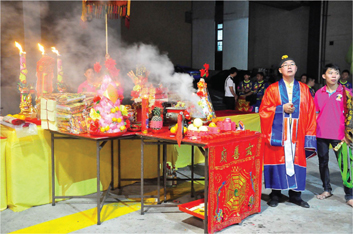
乩童在外面的祭坛恭请玉皇大帝.
渐渐暮色四合,道长进行了更多仪式,包括为信徒带来的新雕像 “开光点眼”(简称 “开光”)。这通常由玉封南府玄善庙的乩童通过附身通灵来完成,但是这次他们在这场仪式中放弃了职责。尽管最终目的都是令这些雕像成为灵验的圣物,但民间和正统的信仰系统和仪式都有明显不同。正统道教认为这些雕像是辅助冥想的工具,既向神灵表示崇敬,也是与神灵交流的一种方式,参与者都坚信 “开过光” 的神像会变成神灵的容器,这样就可以把这位神灵直接请到家里或观中。乩童通过神灵附身,就能为神像 “开光”,而道士诵经礼拜之余,还需要呼唤天神寻求帮助。但两种情况,都需要用一个小刷烧汞,然后点在神像头顶、眼部、耳部、颈部、肩部、心脏、手脚、膝盖、双足以及该神持有的兵器或其他法器上。正统意义上来说,重要器官也需要 “点”,道士会用一面镜子将光线反射到神像上,以提高灵验度。这一过程中,汉字 “灵” 会连同一个神秘符咒一起写在镜子上,道长告诉我,这个符咒 “能带来财富,而镜子的光能除去邪灵(见图七)”。

用镜子反射到神像上来 “开光点眼”.
现在让我们回到玉帝恭请仪式。在焚香、烧纸、诵经、供奉之后,需要再掷一回筊杯,询问玉帝是否接受邀请。在这个环节里,按照统计,投掷两次,每次得到答案 “是” 的几率是 50%–70%,投掷三次则是 87.5%,四次是 93.75%。连续得到四次 “否” 之后,济公起立,鼓励每一个人向玉帝表达崇敬之情,并保证如果他们用心祈祷,玉帝就会同意降临。他开玩笑似的拎起一个婴儿,让他双手合十,并高举空中,很好地号召了众人加入祈祷。杯筊再一次被投掷,而可以确信的是,玉帝默许了。然而,他并没有停留很久。道长告诉我,按照传统,人们在上午 11 点请玉帝,并在当日下午向他汇报所有活动之后将他送离,但是现在当地习俗发生了变化,晚上请来玉帝,次日下午将他送走。我猜测这可能是因为按照宗教历法,从 11 点开始仪式是鉴于大多信徒白天很忙,但随后观礼的乩童告诉我,是他们想在天刚亮的时候第一时间向玉帝祝祷,“我们需要在早上 5:45 向他祝祷,这样他才能听到我们的祷告。他从第一天就开始见证这场仪式,接着其他神仙也会来观礼(见图八)。”

再掷杯筊来确定玉帝已经接受了供奉之物.
因此,次日的主要仪式就是送走玉帝,这是通过由乩童在这一整天里所主持的个人请愿、治疗、净化以及改运仪式会来完成。我疑惑为什么仙阶较低的五方大将需要日日延请,而玉皇大帝仅延请一天,解释则是玉皇大帝在这五天中的职能要远远大于前者,那么最重要是事先将所有计划好的活动告知给他。

在玉帝的祭坛表达敬意和谢意.
送神仪式场面宏大,需要不少道士和乩童,还有大量的食物供奉。供奉需要五种 代表五方五行的水果,一个猪头并猪尾——以示整猪的猪尾极为重要,其他则是献给五方大将的供品,信徒们会在之后分食这些供品,以求获得祝福。在重复之前的夜间仪式过程之后,一旦确定玉帝对进程满意之后,放置在道观之外的玉帝祭坛就会被拆除,然后运送到主干道上的公共焚化箱,在火焰中为玉帝 “饯行”,使之回到天庭。最令人感兴趣的是这个祭坛,它包括一座用纸板做的宫殿,神像装饰其中,并以甘蔗掩映。之前,这类的宫殿是没有的,但之后随着财力提升,新加坡的节庆变得越来越复杂精细,为了 “长脸面”,或者 “追上邻居” 等等,宫殿或者其他可燃物品变得越来越先进,规模也增大了。道长简明地表述道:“这和道教无关,而与财富有关。”只有一件物品免于火焚,就是放在冥币堆上的麒麟财神像,从乩童的角度来看,这意味着财富将顺着玉的祝福在来年源源不断地涌入道观。甘蔗则蕴含着一个福建传统,相传,帝王时期的中国或日本士兵在闽南语地区实施屠村的时候,村民会在甘蔗田里躲避。以这个故事为基础,后来衍生出许多不同版本的故事。,最近的一个在新加坡的例子是 1942 年 2 月,在日军占领新加坡的前几周,几名福建裔的老百姓藏在自家种的甘蔗地里逃生。另一个解释则基于同音词,在闽南语中,甘蔗(gam jia)和感谢(gam xia)发音相似。同音词,作为创造象征物件的基础,还有不少其他的例子,如供品中有苹果,它的第一个音节在普通话里与平安是相同的;香蕉则和 “金招” 相近,因为在闽南语里都念作 “gimjio”;凤梨在闽南语中被念作 “onglai”,与旺来同音。而橘子在闽南语的发音是 “gela”,第一个音节橘是 “gel”,和闽南语大吉 “dai gel” 的 “吉” 发音相同(见图九和十)。
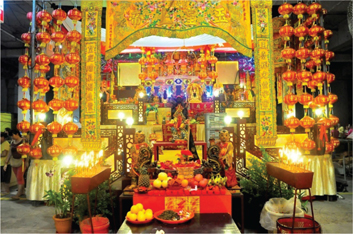
在玉帝的祭坛后面是其临时所用的宫殿.
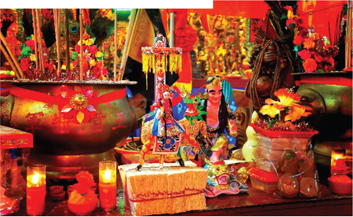
预示来年财源滚滚的麒麟财神.
第三天的重点是过平安桥仪式,过桥之后就会带走身心灵上的负能量,并改变人的运气,将神灵的祝福带给这个人。由于室内缺少操办仪式的空间,玉封南府玄善庙将仪式所用的平安桥放到道观之外的停车场,由黑令(黑旗)保护。黑令在闽南语中被称为 “orhleng” 代表的是冥界之主玄天上帝,还有五方大将的阵旗。平安桥四周,香烛按照八个方向罗列,以表示八卦方位,寻求神灵的帮助:皇天、后土、南斗六星君、北斗七星君、南、北、东、西以及道教的八仙(见图十一和十二)。

求神灵保佑平安桥和周边举行仪式的地方.
每个方向也会随之供上茶水,以示敬意;橘子,代表吉兆;金纸,作为神灵契约性服务的报酬,表示他们的工作不是免费的。桥下放置了一碗有香味的水,象征河流,里面放了一盏油灯,这盏灯并非表示火,而是象征着月色在水上的光影。桥上的五色布条代表五方大将,同时也代表五行:金木水火土,这些构成了道教的宇宙观。平安桥仪式也由道士主持开场和收场仪式,而两位乩童则负责守护进场和出场。道观教众为仪式提供空间,与济公通灵的驻观乩童则负责协调仪式活动(见图十三和十四)。
第一批由道士恭请的神灵是三界守卫,负责保护仪式场地,接着是五方大将,以防恶灵过桥。接着桥迁将军被邀请到一个面对平安桥出口的祭坛,最后邀请土地公。每位神灵请到之后,道士的左手举起一杆相应的大旗,在空中写下一个 “齐” 字符咒,右手则用一条蛇头鞭为每位神灵折裂五次。每一次结绳边缘断裂的时候,就使人联想起闪电鞭笞大地的声音,就像民间神话里的雷公用锤鼓相击,制造闪电杀死滥用法术的魔鬼。并非是鞭子,而是声音起到了避邪的作用。最后,桥上的红馒头会由道士的剑尖除去,而它们每一个都代表着人生命中面对的障碍,这一段情节则象征着移除信徒生命中的困苦,而信徒在之后会跟随道士渡桥。

在水里的油灯代表月光洒在洒在河里.
接着信徒们兴奋地窃窃私语,自发集合起来,按照十二生肖的出生年份分为若干队伍,依次准备过桥,但首先道观的教众会在济公的引导下过桥。桥的入口被称为龙门,负责清除晦气;而出口被称为虎门,负责阻挡晦气,从而在渡桥的过程中,也许是出于期望,会产生一种欢欣鼓舞的感觉。被莲花三太子附身的乩童站在入口,来阻挡鬼魂跟随队伍渡桥。作为五方军队将领的中坛元帅,则站在出口,他有权管理桥上的灵魂。每位参与者通过虎门的时候,他会用门前的旗尖轻触他们。在道教中,神的法力—— “灵” 会通过旗子得到转移,并以此作为一种赠福,感觉就像一股凉气如电流一般穿过身体,从头顶直至脚尖,最后归回大地。渡桥后,每名参与者会在守桥大将的祭坛前敬拜一番,根据民间传统这位大将能够帮助信徒们扫除人生道路上的障碍困苦(见图十五)。

济公引导教众过河.

中坛元帅挥舞旗子给过桥的人降福.
过桥的时候,非本观的教众信徒们每人会分到三支香、一千金纸,改运纸以及一个被称为 “替身” 的男像或女像。替身替代本人接受厄运和恶鬼,这样如果一个人因为自己本身的原因,导致被鬼跟随,那些鬼则会随着仪式后替身和金纸的焚烧而化为灰烬。在打开平安桥之前,道士带着三个替身过桥,并解释道:“男人的霉运比女人少一些,因为女人有生育的风险。我们已经持续进行了 12 个月的转运仪式,我负责六个男人和七个女人,每个月为其中的一个做法,另外还有一个是有生育的危险(见图十六)。”

在灵界替代参与者本人的 “替身”.
直到十二生肖的信众都依次过了桥,在道长们和观内教众的带领下,每个人会再次过桥,他们手中拿着 11 支香,这些香会在之后带进观内,分别插在 11 个香炉内,用于敬拜观内不同的神灵。敬拜顺序是玄天上帝、玉皇大帝、善财童子和其他天神(使用主香炉),千手观音、五方大将、太岁、阎罗殿、最普遍的城隍、黑白无常、印度神象神(Ganesh)、马来神拿督公(Datuk Gong)、代表财富的虎爷将军以及最后守护天地祭坛的一对神犬。
进香之后,每名信徒会从济公手里收到金纸和一把清洁用的 “刷子”。这时,这些金纸被当作改运钱,而刷子则用来清除信徒自己身上的气味。这一步骤也包括在平安桥仪式中(见图十七)。

在平安桥仪式中清除气味的步骤.
同时,道士会在观外用一把剑拆除平安桥,剑身上有用石头镶嵌的北斗七星。移除所有仪式用品之后,神灵也回到了观内,而平安桥的一脚被吊在空中,随着急促的坠毁声响起,凡间与灵界的通道就消失了(见图十八)。
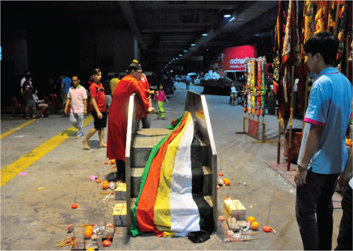
拆除平安桥.
按照计划,晚上主要有两个安排。首先,观内教众开始为倒数第二天的祖先超渡做准备,而观内,附身在乩童身上的观音则开始接受信徒们的咨询和求助。当她说出饱含智慧、大有助益的话语,很多信徒都十分感动,有些甚至热泪盈眶(见图十九)。

附身在乩童身上的观音在接受信众的咨询.
对于大多数参与者来说,超渡祖先是这五日庆典中最为重要的仪式。对于那些最近有亲戚去世的信徒来说,这是一种确定已故亲人已经快速通过冥界并进入轮回的方法,而对于其他人来说,这能向祖先传达敬意并能在供品里接受他们的祝福。为第五天的超渡仪式做最初准备的时候,第四天的仪式则是为年轻一代举行的,为了帮助他们专注于学业,并顺利通过考试。
道长和济公都会参加这场仪式,作为考神魁星的有效媒介。每个家庭都会获得一个放满仪式用品的托盘,包括黑纸做的毕业帽、红纸做的官帽(中国古代高官戴的帽子)、纸袍、金纸、一个代表五路财神的元宝形盒子以及一些考卷的仿制品。这些东西都被济公点过,因此都 “开了光”,那么神灵的法力就能借此验效,同时济公会再加上三枚代表五路财神的铜钱(见图二十)。道长诵经之前,他会拿起每样东西在香烟上转三回。学生(或家长,在学生不在的情况下)则在济公面前跪下,并带上帽子象征成功毕业,济公会鼓励孩子们努力用功。而受到这种信仰体系契约本质的驱使,除了金元宝之外的东西都会被焚烧,作为祭品献给魁星。

点朱砂来加增灵验度.
二爷伯通过附身在他的乩童身上,监督这一天所有的宗教活动。二爷伯的情绪通常是沉郁的,但在这个场合,会变得前所未有的随和快乐。图二十一中,可以看到他正在为米袋施福。随后,这些米袋会和其他必需品一起分发给新加坡西部贫困家庭的老人们。

二伯爷用捉鬼链给米袋施福.
开始的三天,会有唱戏和其他傀儡戏表演,之后则按照仪式将舞台拆除,取下那里的符咒。那些符咒是用来保护表演者,防止他们被扮演的鬼魂或傀儡所代表的神灵和历史人物附身。就像拆除平安桥的过程一样,这些贴在舞台上的符咒会被焚烧,而它们所代表的神灵也会回到观中,之后舞台会被吊起,在地上摔碎。

二伯爷在喝蓝带马爹利.
然后,二爷伯会用剩下的时间和观中教众畅饮蓝带马爹利。玄善庙外,超渡仪式仍然继续准备着,道观的入口处设下为祖先的灵魂和孤魂野鬼分别准备的纸屋,安置等待超度的灵魂。纸屋按照楼层分别安置不同性别的灵魂,而房屋末尾会有一个供所有鬼魂使用的洗手间。与供奉的食物一起,这些纸屋被施以符咒来增加他们在灵界的大小,也就是说纸屋的实际大小与分配给祖先和游魂的住所并没有对应的关系(见图二十二和图二十三)。

安置等待超度灵魂的纸屋.
第五天上午的时间用于在供桌上摆满敬奉祖先的供品,而另一个单独的祭坛上,三名道士则念经拜忏,来解脱死者前生的罪孽,。冥界神灵的帐篷前的正中摆供桌,所供奉神灵的位置是按照加快冥界运作的速度而安放的。在新加坡,这样的神帐一般会用阴暗的灯光点亮,因为冥界的神灵不习惯阳光,这里包括了冥界的主要神灵,也有为他们准备的娱乐用品,如麻将、纸牌、酒水和筹码。主祭坛放上了司判的包公、城隍神,还有誓言 “地狱不空,誓不成佛”的佛教地藏菩萨。神帐两侧摆放着城隍神的 24 个助手,城隍的职责是记录每个人的生平,以保证他们在来世获得相应的奖惩(见图二十四)。

阴间帐篷的两侧分别摆放 12 个城隍神的助手.
同时,观内正在举行一个独特的仪式。龛桌前,放了一个装满各种干豆的食槽,和用来喂食五方大将的坐骑所用的食槽有些相似。这些干豆食槽已经依次经过 “首领”(被最高神祗俯身的乩童)玄天上帝、道长和二爷伯的赐福。显然,他们是非常珍贵的,因为他们代表思想,精神和物质等各个方面的富足:观中侍奉最久的教众各自拿着粉色纸袋走向坐在宝座上的二爷伯,二爷伯就会用槽里的干豆将袋子装满。这些纸袋被小心翼翼地用塑料袋包裹起来,以防漏 “财”。接着二爷伯叫我到前面,声称我是他的代表,然后他就靠在宝座上,看着每个人走向我,向我鞠躬,奉上他们的粉纸袋,我也如其所愿,慷慨地装满它。仪式一结束,二爷伯会回归冥界,由三爷伯代掌。三爷伯是一名主司孝道的冥界神祗,他将负责监督超渡仪式(见图二十五和二十六)。
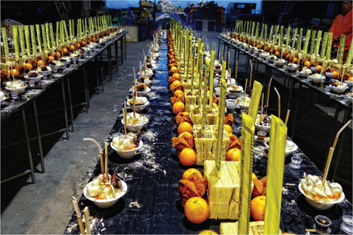
食物和纸钱:给祖先的供物.
接着,让我们转到到户外在供桌上摆放供品的环节。每位祖先都需要供上食物和钱财,为了让他们都能找到各自的供品,每一叠冥币上会贴上写有祖先姓名的黄色符纸。接着,依次点香,召唤祖先享用供品。尽管这个步骤吸引了大多数人的目光,其实最重要的仪式是由道士们主持的祈求玉皇大帝为祖先化孽祈福。因为正统道教的仪式是不会招冥界神灵,也不会在观内展示冥界神灵的人像,我就询问他们在冥界神龛前主持这场超渡仪式的感受,他们回答说,当他们 “一心一意” 为祖先化孽祈福的时候,就渐渐忽略了这些差异。对于孤魂野鬼,也就是那些没有后代供奉祭奠的灵魂,则为他们准备赎罪和自悔的经文,并翻开供他们阅读。最后会再次投掷杯筊确定祖先和玉帝已经满意并接受供奉之后,仪式就此结束。

道士们在为信众的祖先化孽祈福.
用来安置灵魂过夜的纸屋和好几吨的冥币随后由卡车载走,而令我吃惊的是,还有好几桌饭菜,都会送到焚化箱为神灵 “饯行”。据乩童说,焚烧的过程中,纸屋里的灵魂就会重新回到冥界,之前的仪式也是为他们离开人间做准备。在新加坡,只有政府认证区域才能使用明火,在这场仪式中,道观所在的大厦楼下,沿路就有供焚烧的大笼子。在道长和三爷伯的监督下,再次投掷杯筊直到得到 “是” 的答案,那么就可以焚烧冥币。

食物会被焚烧使祖先的灵魂回到冥界.
当火焰燃烧时,道长摇着铃,口述祝祷,其他人则默默祈祷获得祖先的庇佑。一分钟之内,房子就被整个点着,我站在火焰边上观看了 20 分钟之后,火焰渐渐吞没了供品(见图二十七至三十)。

当祖先的灵魂回到冥界时为他们诵经祈祷.
大约直到 1 月 1 日的凌晨 1 点半,火焰才渐渐熄灭,所有人回到了观内。
庆典的最后一天的安排主要是年度盛宴。盛宴的主要目的一方面是拍卖法器圣物为次年筹集善款,另一方面也是一种建立网络关系的工具,因为很多乩童道观都在宴

纸楼点燃,其内的灵魂也就回到冥界.

在阴间使用的钱和食物.
席上预定了桌位。这场宴会在道观所在的大厦前面的停车场里举行,大约有上千人参加。请看本文的第一张五方大将的照片,为了拍卖,他们所穿的衣服被除去,被分别放在一大堆金纸上,接着就和各种手掌大小的护身符一起,分别以 1000 新加坡币以上的价格出售。
每次宴会最重要的仪式物品是旺财炉。作为一个实物,它是道观中常见的法器,但作为一个仪式用具,则含义颇深。首先,它是观中主要法器的微缩复制品;其次,它是通过法式受到观中神灵的认可;最后,信徒可以用它来向神灵祝祷,所以也被认为是观中主香炉的微缩品。对于拍卖获得者来说,得到它意味着将道观中重要的神灵请到自己的家中,像客人一样住一年,保佑他们的家庭和生意。它也代表了财富和繁荣,如果你请回家中,这位神灵会让你财源广进,荣华富贵。拍卖获得者只有一年的时间拥有旺财炉,因为在第二年的拍卖开始时,就要归还。一户人家或生意人只有连续三年拍得旺财炉,才可以永久拥有它。所以,如果一名拍卖者已经连续两年拍得了这具颇有声望的法器,那么在第三次拍卖的时候,就用相当高的数额来竞拍,这样就可以将旺财炉变为他们的财产。竞拍活动和旺财炉都是新加坡大多数小型道观收入的主要来源,但是这却不存在于台湾和马来西亚的道教活动图景中。此次宴会中,旺财炉以一个吉利的数字 10,888 新加坡币的价格成交,相当于 7,200 欧元(见图三十一)。

赢得竞拍者捧着旺财炉.
宴会之后,观中教众上楼回观,清除一切仪式装饰,将原先收拾起来的法器重新秘密归置,并把神像重新放回主龛里。结束之后,年度庆典的最后仪式就是犒劳五方大将和他们的战马,并为之饯行。整场饯行仪式中,会用玄天上帝符表示对焚烧仪式的许可。那么,换一个角度来说,神灵本身也为乩童活动和乩童的法力提供了正当性(见图三十二至三十四)。

准备为五方大将的战马饯行.

烧纸钱作为给大将的犒劳.

一位移民的劳工观看火焰熄灭.
最后,在壮观的火焰映照下,将近一周的仪式庆典圆满落幕。
参考文献
Teo P., S. A. Yeoh, G. L. Ooi, and P. Y. Lai. 2004. Changing landscapes of Singapore 变化的新加坡风貌. Singapore: McGraw Hill 教育出版社新加坡.Search in Google Scholar
©2016 by Fabian Graham published by De Gruyter
This article is distributed under the terms of the Creative Commons Attribution Non-Commercial License, which permits unrestricted non-commercial use, distribution, and reproduction in any medium, provided the original work is properly cited.
Articles in the same Issue
- Frontmatter
- Research Articles
- Bridging Hmong/Miao, Extending Miaojiang: Divided Space, Translocal Contacts, and the Imagination of Hmongland
- “Disabled” Education Reform and Education Reform’s “Disability” A Case Study of an NGO’s Deaf Education Program in China
- The Competition for Gifts: The Social Mechanism of the Revival of Popular Religion – An Ethnographic Study of Fu Village in Eastern Zhejiang
- Visual Anthology
- The Temple of Mysterious Virtue – 29th anniversary celebrations, December 27 2013 – Jan 31st 2014, Singapore
- Review Essay
- Counting Christians in China: A Critical Reading of “A Star in the East: The Rise of Christianity in China”
Articles in the same Issue
- Frontmatter
- Research Articles
- Bridging Hmong/Miao, Extending Miaojiang: Divided Space, Translocal Contacts, and the Imagination of Hmongland
- “Disabled” Education Reform and Education Reform’s “Disability” A Case Study of an NGO’s Deaf Education Program in China
- The Competition for Gifts: The Social Mechanism of the Revival of Popular Religion – An Ethnographic Study of Fu Village in Eastern Zhejiang
- Visual Anthology
- The Temple of Mysterious Virtue – 29th anniversary celebrations, December 27 2013 – Jan 31st 2014, Singapore
- Review Essay
- Counting Christians in China: A Critical Reading of “A Star in the East: The Rise of Christianity in China”

